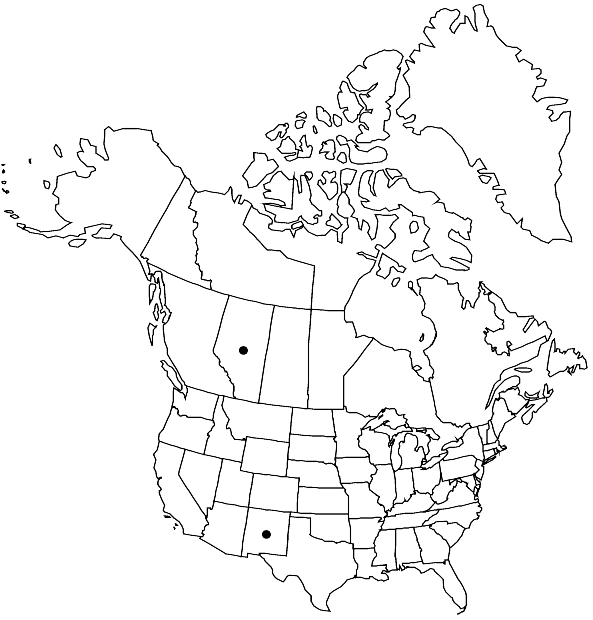Difference between revisions of "Schistidium atrofuscum"
Laubm. Deutschl. 1: 713. 1889,.
FNA>Volume Importer |
imported>Volume Importer |
||
| (6 intermediate revisions by 2 users not shown) | |||
| Line 6: | Line 6: | ||
|place=1: 713. 1889, | |place=1: 713. 1889, | ||
}} | }} | ||
| − | |basionyms={{Treatment/ID/ | + | |basionyms={{Treatment/ID/Basionym |
|name=Grimmia atrofusca | |name=Grimmia atrofusca | ||
|authority=Schimper | |authority=Schimper | ||
| + | |rank=species | ||
| + | |publication_title=Syn. Musc. Eur. ed. | ||
| + | |publication_place=2, 240. 1876 | ||
}} | }} | ||
|synonyms= | |synonyms= | ||
| Line 25: | Line 28: | ||
|elevation=moderate to high elevations (1500-2300 m) | |elevation=moderate to high elevations (1500-2300 m) | ||
|distribution=Alta.;N.Mex.;Eurasia. | |distribution=Alta.;N.Mex.;Eurasia. | ||
| − | |discussion=<p>Schistidium atrofuscum may be the rarest North American species of the genus. It is characterized by its dark brown or nearly black, compact cushions or tufts, mostly erect, moderately keeled leaves, often 2-stratose distal lamina, and the short or rudimentary, strongly perforated peristome. G. N. Jones (1933) listed this species from Tennessee, but that has not been confirmed.</p> | + | |discussion=<p><i>Schistidium atrofuscum</i> may be the rarest North American species of the genus. It is characterized by its dark brown or nearly black, compact cushions or tufts, mostly erect, moderately keeled leaves, often 2-stratose distal lamina, and the short or rudimentary, strongly perforated peristome. G. N. Jones (1933) listed this species from Tennessee, but that has not been confirmed.</p> |
|tables= | |tables= | ||
|references= | |references= | ||
| Line 34: | Line 37: | ||
-->{{#Taxon: | -->{{#Taxon: | ||
name=Schistidium atrofuscum | name=Schistidium atrofuscum | ||
| − | |||
|authority=(Schimper) Limpricht | |authority=(Schimper) Limpricht | ||
|rank=species | |rank=species | ||
| Line 49: | Line 51: | ||
|publication year= | |publication year= | ||
|special status= | |special status= | ||
| − | |source xml=https:// | + | |source xml=https://bitbucket.org/aafc-mbb/fna-data-curation/src/2e0870ddd59836b60bcf96646a41e87ea5a5943a/coarse_grained_fna_xml/V27/V27_284.xml |
|subfamily=Grimmiaceae subfam. Grimmioideae | |subfamily=Grimmiaceae subfam. Grimmioideae | ||
|genus=Schistidium | |genus=Schistidium | ||
Latest revision as of 22:25, 5 November 2020
Plants in compact cushions or tufts, dark brown(-olivaceous) or near black. Stems 0.6–2.5 cm, central strand distinct. Leaves usually erect, occasionally slightly curved, sometimes towards stem when dry, ovate-triangular to ovate-lanceolate, moderately keeled distally, 1.2–2.1 mm, with 2-stratose patches or striae or 2-stratose distally; margins weakly recurved to just before the apex, distal half often plane, proximally often more broadly recurved on one side of leaf, 2- or 3-stratose; apices obtuse or subacute; costa sub-percurrent or percurrent, rarely excurrent as a tiny awn, smooth; basal marginal cells quadrate with transverse walls sometimes thicker than longitudinal walls; distal laminal cells usually rounded or short-rectangular, 6–9 µm wide, smooth, weakly sinuose. Sexual condition autoicous. Capsule orange- or red-brown, often yellowish, short cylindric or cupulate, 0.75–1 mm; exothecial cells primarily elongate mixed with patches of irregularly angular isodiametric cells, walls sometimes unevenly thickened and curved; stomata absent; peristome patent, very short, 30–100 µm, or rudimentary, orange or orange-red, densely papillose, strongly perforated and unevenly margined. Spores 11–15(–19) µm, granulose or smooth.
Phenology: Capsules mature late spring to early summer.
Habitat: Open to somewhat shaded limestone
Elevation: moderate to high elevations (1500-2300 m)
Distribution

Alta., N.Mex., Eurasia.
Discussion
Schistidium atrofuscum may be the rarest North American species of the genus. It is characterized by its dark brown or nearly black, compact cushions or tufts, mostly erect, moderately keeled leaves, often 2-stratose distal lamina, and the short or rudimentary, strongly perforated peristome. G. N. Jones (1933) listed this species from Tennessee, but that has not been confirmed.
Selected References
None.